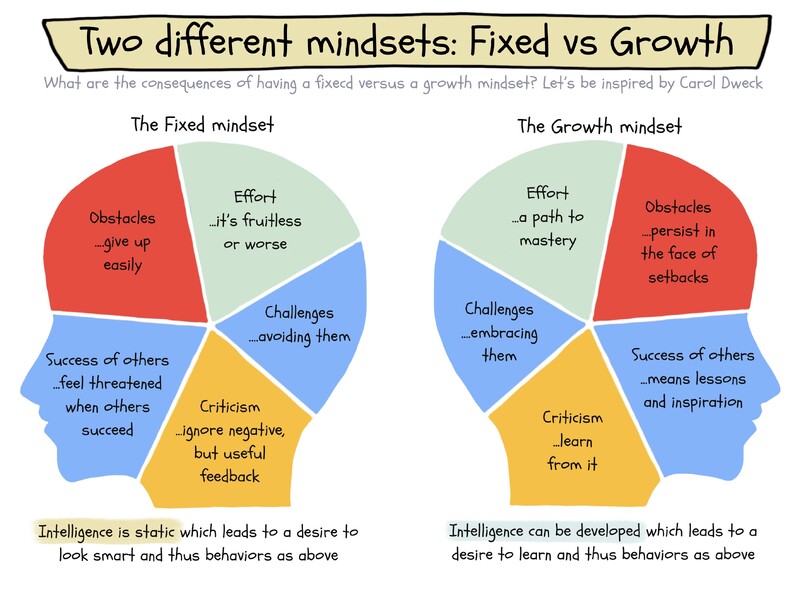
GUEST POST from Stefan Lindegaard
What does it mean to have a mindset? How does it shape your actions, and those of the people you interact with? Is it steadfast, or does it evolve? Could it perhaps be a fusion of elements? It’s crucial to understand mindsets as they influence not only our behaviors but also the behaviors of those we engage with, allowing us to better navigate the world.
Research defines “mindset” as a mental frame or lens that selectively organizes and interprets information, orienting an individual’s understanding of experiences and guiding their responses and actions. This definition, adapted from Carol Dweck by Salovey and Achor, illuminates that our mindset, composed of our thoughts and beliefs, influences our perception of ourselves, our environment, and the broader world. Such understanding is vital in team dynamics, leadership, and organizational contexts.
Dweck identified two primary mindsets:
- A fixed mindset, in which intelligence is viewed as static, leading to the desire to appear intelligent and influencing specific behaviors.
- A growth mindset, where intelligence is seen as something that can be developed, sparking a desire to learn and driving diverse behaviors.
The growth mindset, characterized by the belief that abilities can be honed with consistent effort, is shaped by how we perceive and tackle five critical areas:
- Viewing effort as a path to mastery
- Demonstrating persistence in the face of obstacles
- Seeing others’ success as a source of inspiration and learning
- Embracing challenges
- Welcoming criticism as an opportunity to learn and grow
However, we need to acknowledge that our mindsets aren’t strictly “fixed” or “growth” in nature. They’re typically a hybrid of both, influenced by the context and phase of our lives. It’s is also situational. Our response to situations can shift, revealing the dominance of one mindset over the other at different times. Recognizing this within ourselves and avoiding prematurely labeling others is vital.
Here are a few case study examples:
Case Study 1 – Education
To give a practical example, let’s look at the world of education. Imagine a student who struggles with math. With a fixed mindset, they might think, “I’m just not good at math,” and subsequently put less effort into learning. However, if they adopt a growth mindset, they would perceive math as a challenge they can overcome with practice and effort. Using different strategies and seeking help when necessary, the student’s math skills can improve, highlighting the practical application of a growth mindset.
Case Study 2 – Microsoft
In the business world, Microsoft provides an excellent case study. Under CEO Satya Nadella’s leadership, Microsoft shifted from a fixed to a growth mindset. Nadella introduced Dweck’s growth mindset concept to the company culture, fostering innovation and collaboration. The shift, encapsulated in the motto “Learn it all” vs. “Know it all,” encouraged employees to remain open-minded, learn from their mistakes, and continually improve. This change in mindset led to increased employee engagement, innovation, and contributed to Microsoft’s recent growth.
Case Study 3 – Sports
In sports, athletes often exemplify the growth mindset. Consider basketball legend Michael Jordan. He was cut from his high school varsity team because he was deemed “not good enough.” Rather than accepting this as an unchangeable state, he viewed it as a challenge and redoubled his efforts to improve. His eventual rise to becoming one of the greatest basketball players of all time showcases how a growth mindset can lead to superior performance in the face of setbacks and criticism.
Conclusion
As I often say, “The essence of the growth mindset in an organizational context is to instill a mindset focused on continuous improvement rather than the need to prove that one is the best.”
Implementing the growth mindset in team dynamics is part of my work. However, it doesn’t stand alone. It must be complemented by other factors like fostering a learning culture, ensuring psychological safety, and navigating the comfort zone. All these components are critical to effective team, leadership, and organizational development.
Image Credit: Stefan Lindegaard
![]() Sign up here to get Human-Centered Change & Innovation Weekly delivered to your inbox every week.
Sign up here to get Human-Centered Change & Innovation Weekly delivered to your inbox every week.